| The question of names may strike you as trivial at first: A simple, superfluous detail to be tacked on at the end. Would that it were so! In fact, names are crucial to user understanding of what the site does and how it works. Well-chosen names are invisible; they quietly point users in the right direction without calling attention to themselves. Whereas poorly chosen names slow users down, confusing them and undermining their confidence. "Labeling is an important part of information architecture," says Steve Mulder, manager of User Experience for Terra-Lycos. "We've seen this in the usability lab. We've seen very simple naming issues completely prevent users from completing a task." Section names should be Short. You don't have a lot of room to get your point across. So names should be short and to the point. Consistent. Section names should all use similar phrasing to show their relationship to each other. Clear. The more descriptive and literal your section names are, the more likely users are to click on them. Jargon-free. Customers don't understand the specialized lingo of your industry. So you'll have to translate labels into a language they understand.
choose short names Space is always at a premium online. You have a lot to convey, and not a lot of room in which to convey it. The width of the screen will always limit the width of your words. So pick the shortest, most accurate words(s) you can. "You must call each thing by its proper name, or that which must get done will not." A. Harvey Block, President, Bokenon Systems choose consistent names When you're labeling several sections that will appear together on a nav bar, the names should be as consistent as possible. Ideally, the names or phrases should agree on the number of words, part of speech, verb tense, capitalization, language, and so on. The issue here isn't grammar, but comprehension. Users will understand categories (and your site as a whole) more quickly if the names agree with each other. Humans are natural-born categorizers; if they perceive a parallel between sections, they'll immediately bundle them together, allowing their understanding of each new category to build on the knowledge of the previous category. But seemingly small inconsistencies will trip them up, making them re-sort the words in their mind. The issue isn't grammar, but comprehension. Users understand categories more quickly when the names are consistent.
Often, subtle changes in language can make significant improvements in user comprehension. (And this is an area where even split-second differences can impact a user's impression.) For instance, if you have areas on your site for both buying homes and buying cars, you should avoid mismatched names, like "Buy a Home" and "Cars." Instead, choose a single scheme: either "Buy a Home" and "Buy a Car" or "Homes" and "Cars." (See choosing consistent names, p. 124.) choose clear names The most important thing about the labels on your site is that they accurately represent the section's function or contents. In other words, you should call things what they are. Sounds pretty basic, but this very simple rule is violated on four out of five sites. Why? Because people like to name things, and people like to be clever. So instead of calling our news section, "News," we name it "Currents" or "Talk of the Town." Rather than tickle your user's tongue with alliterations and puns, focus on choosing labels that are short, simple, and specific. (See why section names should be clear, not clever, p. 126.) choosing jargon-free names Every industry and every company has its own lingo a specialized way of talking about its products and the world that make perfect sense to them and none to anyone else. There's nothing inherently wrong with jargon. But you have to keep it off your web site that is, if you want anyone to understand it. "Jargon is rampant inside companies," says Jesse James Garrett, an information architect who's consulted for companies large and small. "All kinds of companies have their own special language for products and features. There's the language they use internally, and there's the language they impose on external communications for marketing reasons." Jargon often creeps on to web sites, because people are used to describing products in their own industry terms. Often, they don't even realize they're using jargon. "One of the hardest transitions for people to make in any given business is from the mind of the seller to the mind of the buyer, and from the language of the seller to the language of the buyer," says online marketing expert Hunter Madsen. The link, "My Chapter," lets users find a Sierra Club group near them. But the word "chapter" is confusing, because it has a more commonplace meaning.  His advice: "Go through your entire web site, identify every term that looks like an inside or category term, circle it, and ask if there isn't an easier word that you hear your buyers use the improper term they use for the phrase you would prefer. Then switch your web site's verbiage to fit the buyer's venacular." what does "jargon" mean? Acronyms that aren't self-explanatory. Code words used in the company. "In large organizations, it's often easier to sell your work internally when you use the company's buzzwords, division names, and so on," said designer Jeffrey Zeldman. "But you pay a price for doing so." Double entendres, or words that have two meanings. "The classic example in computer science is the word 'default,'" says Professor Michael Twidale. "We all know what default means. But if you're building software for an accountant, they also know what "default" means. And it means something completely different." Formal or technical words that real people don't use. For example, the Black and Decker site has a section, "Garment Care." But real people call "garments" clothes. Industry terms that customers may not know and would never use. Marketing slogans that you'd like your customers to learn. For example, the juice company Odwalla has a section called "Freshology." Slang that your visitors don't actually use.
What's at stake here isn't just comprehension, but also competition. If users have a choice between two sites one that confuses them and one of that speaks plainly they'll choose the one they understand. As Jesse James Garrett says: "Users can adapt to jargon, but if they have a choice, they won't." choosing consistent names Consistency is one of the keys to an intuitive navigation system. The names on your site sections should be consistent, so users can quickly grasp the relationship between them. Granted, it's difficult to find names that are consistent in every way, but it's what we strive for. factor | | examples | |
|---|
Part of speech | Section name based on a noun or verb. | Good: | Cars | Homes | Bad: | Cars | Buy a home | Verb tense | Labels with verbs should all use the same tense. | Good: | Buy a car | Buy a house | Bad: | Buy a car | Buying a house | Plural or singular | Labels should either all be plural or all be singular. | Good: | Artists | Authors | Musicians | Bad: | Artist | Authors | Musician | Capitalization | The same words should be capitalized in each label. | Good: | Buy a car | Buy a home | Bad: | Buy a car | Buy A Home | Language | Names of foreign laguages should either all be written with the English word, or all be written with the native word. | Good: | English | Spanish | French | Bad: | English | Español | French | Number of words | Labels should all have roughly the same number of words. | Good: | Create Profile | Edit Profile | Search profiles | Bad: | Create a profile | Edit profile | Search all the profiles | Length of words | Labels should all be roughly the same length. | Good: | Buy a home | Buy a car | Buy an RV | Bad: | Buy a home | Buy a car | Buy a recreational vehicle |
|
a few good examples RedEnvelope lets you choose gifts by the recipient, each of which is labeled, "for ____." 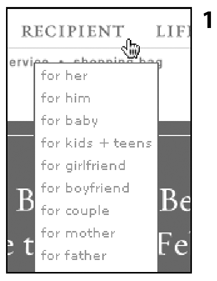 The Guggenheim Museum lets you find artwork based on six characteristics, each of which is expressed with a single noun. 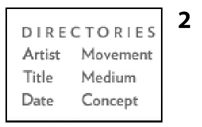 BBC News lets you read articles in many languages each of which is listed in its own language and alphabet.  BackRoads offers many types of trips, each of which is labeled with an adjective and noun.  Nerve.com offers six ways to use their personals, each of which is labeled with two words: a verb and a noun. 
|
lesson from the trenches: why section names should be clear, not clever  "Online, everything has to be totally clear. You can't call search 'Quest'. " Jim Frew We humans have an inexplicable urge to name things. We name our children, our pets, our toys, our cities, neighborhoods, and streets. We've been known, on occasion, to name our body parts. Every industry, it seems, has a self-indulgent name game. Magazines come up with clever names for each section, column, and story. Car companies devise different names for makes and models. The cosmetics industry, for its part, has produced more names for nail polish than there are stars in the sky.[*] For the most part, this is a harmless fetish. If you want to give a clever name to every clever column in your clever magazine, who will it hurt? But on the web, it hurts both your users and your site. Using vague, obscure names for site sections leads to confused and frustrated users. The web doesn't provide enough contextual clues to help the user understand that "Thorn Tree" means "Discussion area." And if they don't know what's behind a link, they're unlikely to follow it. "Following a link is like buying meat packaged meat," laughs Martha Brockenbrough, former managing editor of MSN.com. "You don't want it to just say, 'MEAT.' You want it to say what animal it came from. You want to see the freshness date. You want to be able to see the product. You want to see: Does it have that rainbow hue? Or is it still looking good?" The same is true on the web, she continues. "People don't click if they're not sure what they're going to get. That's why it's important to have very clear labels. Clear is better than clever, always." This is a hard adjustment for editors who began their careers in print. Magazines and newspapers place a premium on puns and alliterations. But the wordsmith's approach is a recipe for failure online. "On the web, you need a level of clarity that you don't need in other media," says Jim Frew, a designer who splits his time between print and the web. "For magazines, you can choose names that are stylized and kind of cryptic. But online, everything has to be totally clear. You can't call search 'Quest.'" Of course, we didn't always know this. When HotWired launched, for instance, we used magazine-style section names like "Piazza" and "Signal." They were catchy, but they confused our users. Without any other clues, they didn't know what to do or where to click. Needless to say, we learned our lesson. And we weren't the only ones. Producers all over the web were making the same mistake. "I abused section names," Brockenbrough admits. "I named Joel Stein's humor column 'Lúser.' It's French, because he's supposed to be the everyday user. And Ha, ha. Funny pun on 'Loser,' but no one knew what it meant." Her take-away? "Do not try to be smart. Do not try to be clever. Do not try to spin people. You can have a voice and elements of whimsy, but do it with something less critical than your navigation." |
[*] On a very clear night, in a very dark place, 8,768 stars can be seen with the unaided eye. If you count the nail polish colors on the make-up floor at Macy's, you'll see that it's higher...
strange names All kinds of things go wrong when people sit down to name their site sections. The first problem is that they let their company's internal jargon creep onto their web sites. The second problem is that people love to name things, and they love to be clever. But vague, cryptic names lead to confused and frustrated users. Clockwise from left: The names and icons that represent sections on the (1) Lonely Planet site are colorful but mystifying. What is a thorn tree? (It's the discussion area.) (2) HotWired's first front door (circa 1994) featured striking icons and clever section names that baffled users. (3) Sierra Club created clever names that are hard to decode and their grouping which makes them appear related makes matters worse. "Currents" means news. (Why not call it "News"?) "Zoomer" helps you find sites about local issues. (Why not call it "Local Issues"?), and "Lewis & Clark" is surprisingly literal. The section's actually about Lewis & Clark. (4) Odwalla uses marketing slogans as site navigation, with sections called "Freshology" and "People to Planet." (5) 360degrees let technical jargon become site navigation, with a section called "Dynamic Data" that conceals some great interactive features, such as quizzes and polls. 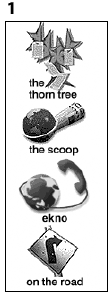 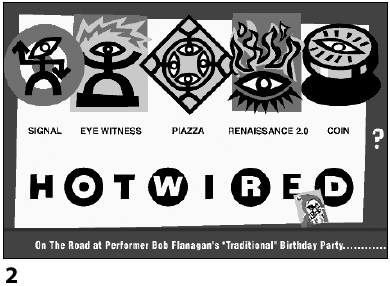 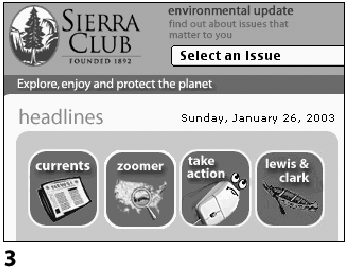 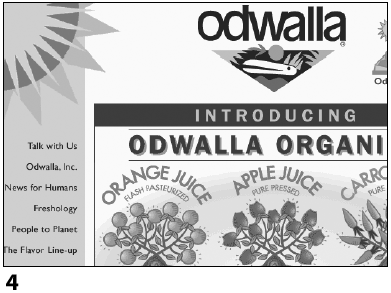  |
action section: how will you name your site sections? If you feel the urge to be creative or clever, channel that energy elsewhere. It's quite important to use simple, clear, boring section names that people can understand. section names Group 1 1. __________________________________________ Is this: |  short short
|  clear clear
|  jargon-free jargon-free
|
2._________________________________________ Is this: |  short short
|  clear clear
|  jargon-free jargon-free
|
3. __________________________________________ Is this: |  short short
|  clear clear
|  jargon-free jargon-free
|
4. __________________________________________ Is this: |  short short
|  clear clear
|  jargon-free jargon-free
|
5. __________________________________________ Is this: |  short short
|  clear clear
|  jargon-free jargon-free
|
6. __________________________________________ Is this: |  short short
|  clear clear
|  jargon-free jargon-free
|
7. __________________________________________ Is this: |  short short
|  clear clear
|  jargon-free jargon-free
|
8. __________________________________________ Is this: |  short short
|  clear clear
|  jargon-free jargon-free
|
9. __________________________________________ Is this: |  short short
|  clear clear
|  jargon-free jargon-free
|
10. ____________________________________________ Is this: |  short short
|  clear clear
|  jargon-free jargon-free
|
Group 2 1. _____________________________________________ Is this: |  short short
|  clear clear
|  jargon-free jargon-free
|
2. _____________________________________________ Is this: |  short short
|  clear clear
|  jargon-free jargon-free
|
3. _____________________________________________ Is this: |  short short
|  clear clear
|  jargon-free jargon-free
|
4. _____________________________________________ Is this: |  short short
|  clear clear
|  jargon-free jargon-free
|
consistency check Do your sections names agree with each other in terms of  Part of speech (verbs vs. nouns) Part of speech (verbs vs. nouns)
 Verb tense Verb tense
 Capitalization Capitalization
 Language Language
 Number of words Number of words
 Length of words Length of words
jargon check Are you quite sure that none of these names are:  Acronyms Acronyms
 Code words Code words
 Double entendres (words with double meaning) Double entendres (words with double meaning)
 Formal words Formal words
 Industry terms Industry terms
 Marketing slogans Marketing slogans
 Slang Slang
|
|












 short
short